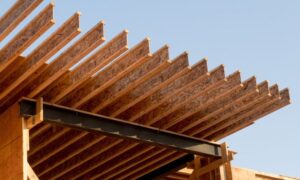Wooden Floor Joists - TJI Joists
What are TJI Wooden Floor Joists?
TJI joists offer an excellent alternative to wooden floor trusses or flat roofs. These high-tech joists combine webs of O.S.B. (Oriented Strand Board) and flanges made from Microllam. They are patterned after steel I-beams. Next time you pass a commercial construction project take a look at the steel beams. Shaped like an I they have very narrow centers with heavy flanges on top and bottom. Look how much weight they can support. Wooden TJI joists work the same way.

Why use Wooden TJI Joists?
TJI joists can use as little as one-third of the wood used in traditional sawn lumber. Resource-efficient, engineered wood TJI joists are manufactured to resist the shape-changing effects of temperature and moisture. Long length, lightweight and versatile, TJI Joists use an innovative design to helps prevent squeaky floors and can be easily drilled and cut for plumbing and ductwork.

TJI Joists Sizes
Depending on the series you choose, TJI joists are available in the following sizes:
Flange Widths: 1 3/4", 2 1⁄16", 2 5⁄16", and 3 1/2"
Depths: 9 1/2", 11 7⁄8", 14", and 16".
Joists are horizontal supporting members that run from wall to wall, wall to beam, or beam to beam to support a ceiling, roof, or floor. The wider the span between the supporting members, the deeper the joist will need to be. Lateral support also increases strength and keeps the TJI joists from deflecting under full load. Our designers use approved formulas for calculating the depth required and reducing the depth as needed. A general rule of thumb for calculating the depth of a wooden floor joist for a residential property is half the span in feet plus two inches; for example, the joist depth required for a 20-foot span is 12 inches.

